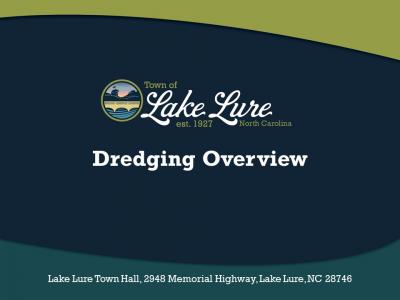Dredging Overview
The Town of Lake Lure sees ongoing dredging as a top priority. As most people know, the act of dredging is when a dredge removes materials from the bed of a body of water and moves them to another place. There are two major dredging methods, Mechanical Dredging and Hydraulic Dredging. (1.)
Mechanical Dredging: In essence, mechanical dredging is the act of using a dredge that digs materials from an extraction site. Most often, there is a stationary, bucket-oriented machine that scoops the desired materials before transporting them to the sorting area. Mechanical dredges remove material by scooping it from the bottom and then placing it onto a waiting barge or into a disposal area. Dipper dredges and clamshell dredges, named for the scooping buckets they employ, are the two most common types. (2.)
Hydraulic Dredging: Hydraulic dredging is centered around the concept of transferring dredged materials from the dig site to a processing location for sifting and sorting. It involves creating a slurry—a fluid mixture comprising elements like rock, dirt, and gravel—which is then transported to a sorting facility. Hydraulic dredges work by sucking a mixture of dredged material and water from the channel bottom. The amount of water sucked up with the material is controlled to make the best mixture. Too little water and the dredge bogs down; too much and the dredge is not efficient in its work. (3.)
Hydraulic Dredging Plan
In April 2024, the Town of Lake Lure held a meeting with the Army Corp of Engineers to confirm that the Town may proceed with Hydraulic Dredging.
- A Request for Qualifications (RFQ) for Hydraulic Dredging has been posted and is out for bid through June 7, 2024.
- NC Division of Water Grant Funds will be utilized to fund this dredging, along with the Town's matching funds.
- The Town received a $750,000 grant in 2023 and this grant required a $250,000 match.
- A small portion of these funds ($220,000) were utilized in 2023 and were carried over in 2024.
Mechanical Dredging Plan
Additional permits will be required for mechanical dredging.
- The Town of Lake Lure plans to submit a Permit Application for Mechanical Dredging by July 2024.
- If approved, it is thought that the Permit for Mechanical Dredging would be received by January 2025.
- Updates will be provided here as new information becomes available.
The Town of Lake Lure will continue to pursue grants to help support dredging moving forward.
Updates - July 31, 2024
Town Council approved the Dredging Contract with Stott Construction, Inc. for hydraulic dredging at the July 9, 2024 Town Council Meeting.
- Mr. Stott signed the dredging standard agreement form the following day.
- Stott Construction has begun dredging operations in the navigational opening to the Washburn Marina as well as Fire Fly Cove.
- The hydraulic dredging pipe is in place.
- The catch basins should be completely cleaned out by the end of this week and hydraulic dredging should begin either late this week or early next week.
The Town is still working with LaBella Associates to obtain an individual permit for mechanical dredging.
- The work order for providing technical assistance with permitting to support mechanical dredging was approved at the July 24, 2024, Town Council Work Session.
- Currently, the engineers at LaBella Associates are working through the requirements related to the Threatened & Endangered Species survey, Cultural Resources, and jurisdictional delineations for the dredge area and potential spoil locations.
Updates - August 28, 2024
- Hydraulic dredging operations began in July 2024 and are underway in the main channel of the lake.
- LaBella Associates and the Town are in the process of obtaining an individual permit allowing larger scale mechanical dredging.
- The current plan is continue hydraulically dredging in this area as needed and to mechanically dredge near Firefly Cove during the lake drawdown.
- We still anticipate receiving this permit in January.
Stay tuned here for updates as new information becomes available.
1., 2., 3.: National Ocean Service and Atmospheric Administration: https://oceanservice.noaa.gov/facts/dredging


